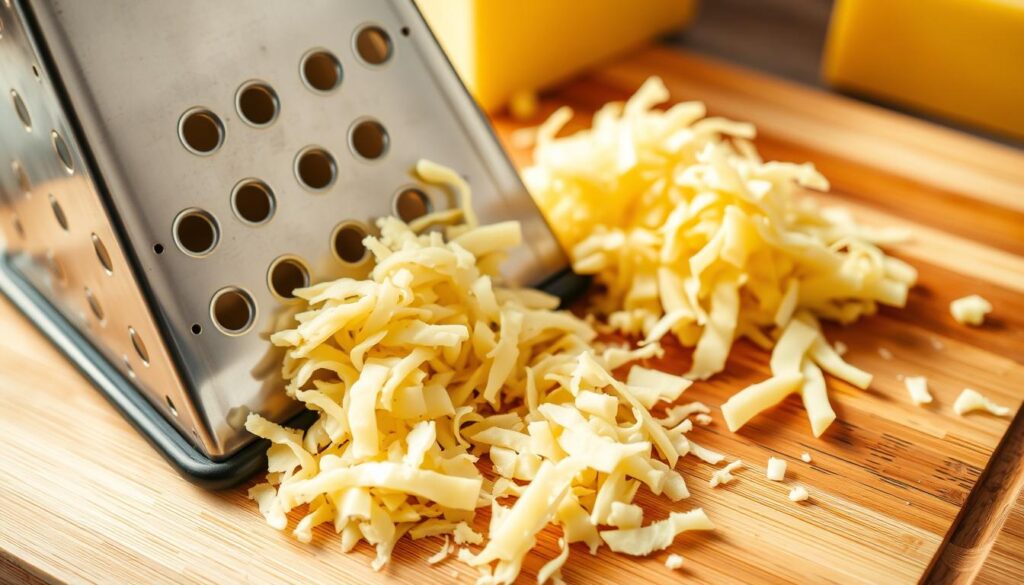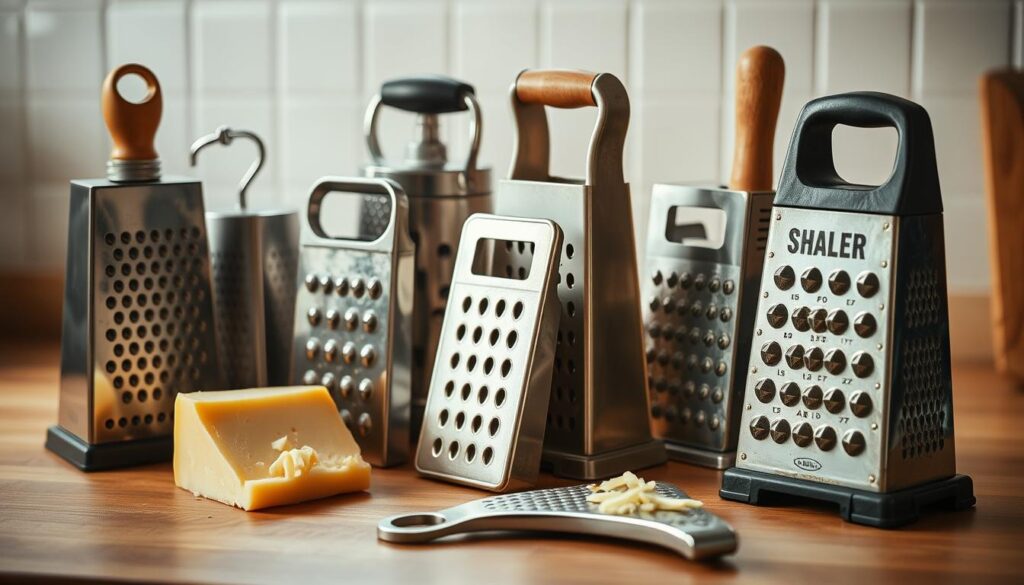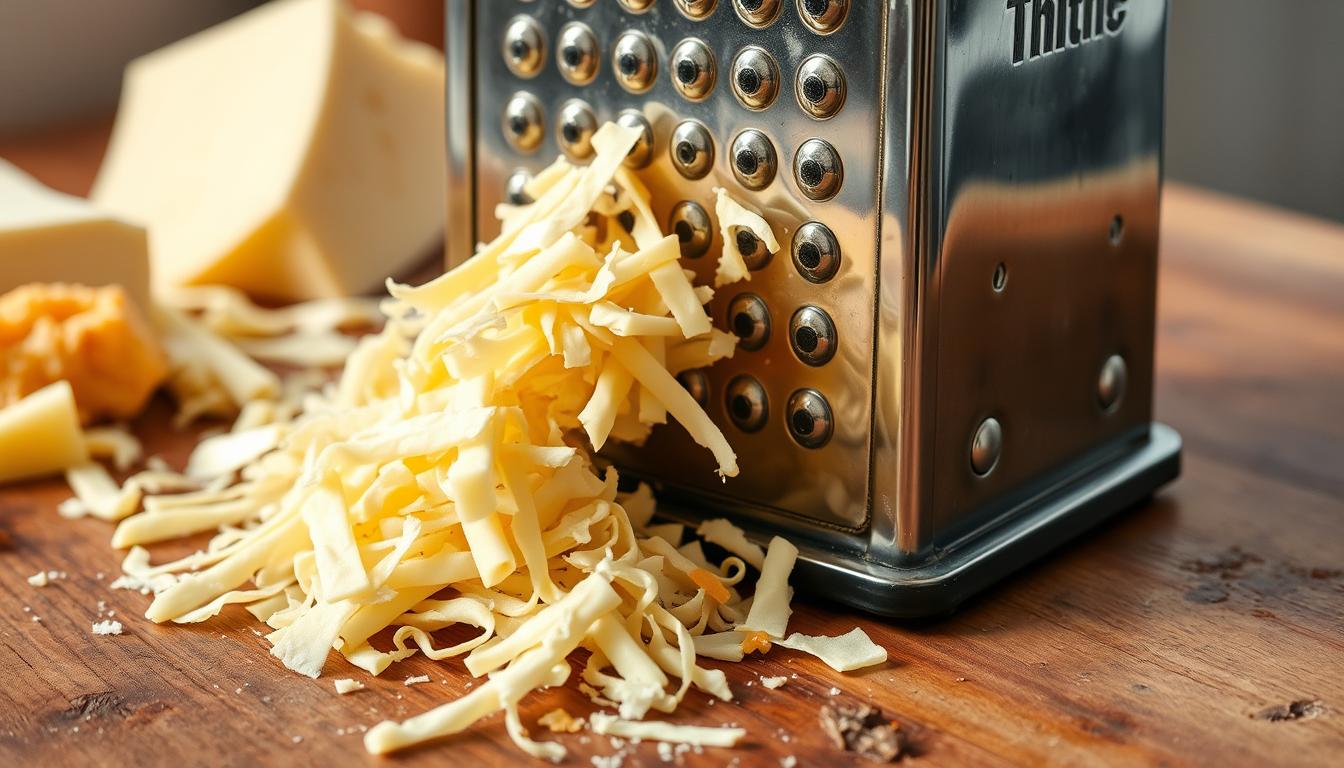Shredding cheese is a simple yet essential task in the kitchen. It can be tricky to get the perfect texture and consistency. Whether you’re topping a piping hot casserole, sprinkling it over a salad, or melting it into a delectable sauce, having properly shredded cheese can make all the difference in your culinary creations. In this comprehensive guide, you’ll discover easy tips and step-by-step instructions on how to shred cheese effectively using a cheese grater.
Key Takeaways
- Understand the different types of cheese graters and how to choose the right one for your needs.
- Learn proper cheese preparation techniques to ensure efficient shredding.
- Discover expert shredding methods for achieving consistently perfect cheese shreds.
- Explore storage solutions to keep your shredded cheese fresh and ready to use.
- Unlock the versatility of shredded cheese and learn how to incorporate it into various dishes.
Introducing the Art of Shredding Cheese
Shredding cheese is key in cooking, making dishes better in taste and texture. It’s used in many recipes, from pasta to appetizers. Learning cheese shredding techniques opens up new cooking possibilities.
Grating cheese right has many benefits. It melts better, making sauces and soups creamy. Shredded cheese also browns faster and looks great.
Shredding cheese is also a calming kitchen activity. The sound of cheese falling and the joy of seeing it all come together are rewarding. It adds to the fun of cooking.
“Shredding cheese is more than just a task – it’s an art form that can transform any dish into a culinary masterpiece.”
Whether making mac and cheese or trying new flavors, shredding cheese is essential. By learning different shredding techniques, you can improve your cooking. Your dishes will taste and look better.

Essential Tools for Shredding Cheese
Having the right tools is key for shredding cheese. Look into the different types of cheese graters. Find the perfect one for your needs.
Types of Cheese Graters
Cheese graters come in many styles. Each is made for different shredding tasks. You can find everything from the classic box grater to the handheld rasp-style grater.
There are also specialized shredding tools like the rotary cheese grater. They make shredding cheese easy and fast.
Choosing the Right Grater
When picking a cheese grater, think about the size of the shreds you want. Also, consider the grater’s material and how easy it is to use. A cheese grater with a large surface can shred more cheese faster.
Look for a grater made of sturdy, stainless steel. It will last longer. Features like a non-slip base or a built-in collector tray can also make shredding easier.
Choosing the right type of cheese grater is all about finding one that fits your needs and preferences. With the right tool, shredding cheese will be a breeze. You’ll be able to make perfectly shredded cheese for your dishes.

Preparing for Shredding Cheese
Shredding cheese is key in many recipes, like loaded fries and mac and cheese. To get perfect shreds, you need to prepare the cheese right. Let’s look at the steps to prepare cheese for shredding and get the best results.
First, clean the cheese well. Use a damp cloth to wipe off dust or debris. This keeps the cheese clean and ensures even shreds.
Then, cut the cheese into pieces that are 1-2 inches big. This size makes shredding easier and more consistent. How to prepare cheese for grating is about getting the right size for easy shredding.
| Cheese Type | Ideal Shred Size |
|---|---|
| Cheddar | 1/4 inch thick |
| Parmesan | 1/8 inch thick |
| Mozzarella | 1/2 inch thick |
Make sure the cheese is slightly chilled for shredding. This keeps it firm and prevents shreds from sticking together.
“The key to perfect shredded cheese is all in the preparation. Take the time to clean, cut, and chill the cheese, and you’ll be rewarded with beautifully consistent shreds every time.”
By following these steps, you’ll master preparing cheese for shredding. This will take your cooking and baking to the next level, adding that perfect, melty cheese touch to your dishes.
Step-by-Step Guide: How to Shred Cheese with Grater
Shredding cheese with a grater is a simple skill for home chefs. It’s great for making delicious dishes or adding tasty toppings. This guide will show you how to get uniform shreds every time.
Positioning the Cheese and Grater
First, pick the right cheese grater for your needs. Place it on a stable surface like a cutting board. Hold the cheese firmly against the grater, keeping your fingers away from the sharp edges.
Keep a steady angle and apply gentle pressure as you move the cheese across the grater.
Grating Techniques for Perfect Shreds
- Start at the top of the grater and work your way down, applying light, even pressure to create long, uniform shreds.
- For harder cheeses, use a back-and-forth motion to shred the cheese evenly.
- For softer cheeses, use a gentle, circular motion to prevent the cheese from sticking or tearing.
- Rotate the cheese regularly to ensure even shredding and avoid flat spots.
Always keep your fingers away from the grater’s sharp edges. Work with small, manageable pieces of cheese for the best results. With practice, you’ll shred cheese like a pro.
“The key to effortless cheese shredding is finding the right balance of pressure and technique. With a little practice, you’ll be creating perfect shreds every time.”
Tips for Effortless Cheese Shredding
Shredding cheese can be easy with the right techniques. Whether you’re making a cheesy casserole or topping a salad, these cheese shredding tips will help you get perfect shreds every time.
Avoid Sticking and Clumping
To stop shredded cheese from sticking, chill the block in the freezer for 15 minutes before shredding. This makes the cheese firm and shred cleanly. Also, lightly spray your grater with non-stick cooking spray to prevent sticking.
Maximize Shredding Efficiency
- Start with a block of cheese at room temperature for easier easy cheese shredding.
- Use a high-quality, sharp grater to create uniform, cheese shredding hacks that melt and distribute evenly.
- Grate cheese in short, quick strokes to prevent it from building up and clogging the grater.
Minimize Waste
Don’t waste those last few pieces. After grating most of the block, use a vegetable peeler to shave off the rest. This way, you get every last bit.
| Cheese Shredding Tip | Benefits |
|---|---|
| Chill the cheese before shredding | Helps prevent sticking and clumping |
| Use a high-quality, sharp grater | Produces uniform, meltable shreds |
| Shred in short, quick strokes | Prevents clogging and buildup on the grater |
| Finish with a vegetable peeler | Minimizes waste by using every last bit of cheese |
By following these cheese shredding tips, you’ll shred cheese easily and get perfect results. Whether you’re making a dish or adding cheese to your favorite meal, you’ll succeed.
Storing Shredded Cheese Properly
Keeping shredded cheese fresh is key to enjoying its taste and texture. Whether you shredded it yourself or bought it pre-shredded, the right storage is crucial. It helps keep your cheese in great shape.
Containers for Storing Shredded Cheese
Choosing the right container for shredded cheese is important. Here are some tips for the best storage options:
- Airtight Containers: Use airtight, resealable containers like ziplock bags or sturdy plastic ones. They keep air out and keep the cheese fresh.
- Moisture-Wicking Materials: Containers with breathable materials, like perforated bags or ones with vents, are good. They let moisture out and prevent the cheese from getting soggy.
- Temperature Control: Keep shredded cheese in the fridge. The cool temperature and controlled environment help keep its texture and prevent drying out.
By following these tips, your shredded cheese will stay fresh and ready for your recipes.
“Proper storage is the key to keeping shredded cheese at its best. Invest in the right containers and maintain the right conditions to enjoy the full flavor and texture of your favorite cheese.”
Versatile Uses of Shredded Cheese
Shredded cheese is a versatile ingredient that can elevate a wide range of culinary creations. It can make savory dishes and sweet treats even better. Discover how shredded cheese can add flavor and texture to your favorite recipes.
Topping Pizzas and Casseroles
Shredded cheese is a staple topping for pizzas. It adds a melty, gooey layer that enhances the flavor and texture. It also works wonders in casseroles, creating a creamy, comforting blanket over the ingredients.
Enhancing Soups, Salads, and Baked Goods
Shredded cheese is great for soups, salads, and baked goods too. Sprinkle it over a hearty chili or creamy soup for added richness. It can also make salads more delightful, both in taste and texture. In baked goods, it improves the structure and mouthfeel, making them irresistible.
| Dish | How Shredded Cheese Enhances It |
|---|---|
| Pizza | Provides a melty, gooey topping that adds flavor and texture |
| Casseroles | Creates a creamy, comforting layer that binds the ingredients together |
| Soups | Adds richness and depth of flavor to the dish |
| Salads | Lends a delightful texture and visual appeal to the overall presentation |
| Baked Goods | Improves the structure and mouthfeel, making the treats even more irresistible |
Whether you’re making a classic mac and cheese or trying new recipes with shredded cheese, this ingredient is essential. It’s a must-have in any well-stocked kitchen.
“Shredded cheese is the secret ingredient that can transform even the most ordinary dish into something truly extraordinary.”
Troubleshooting Common Shredding Issues
Shredding cheese can sometimes be tricky. But, with the right methods, you can solve these problems and get great results. Two big issues are clumping and sticking. These can ruin the look and taste of your shredded cheese.
Dealing with Clumping and Sticking
Clumping is a common problem, especially with softer cheeses. It happens because of the cheese’s oils and moisture. To avoid clumping, chill the cheese well before shredding. Cold cheese sticks less.
Also, dusting the shredded cheese with cornstarch or flour helps. It absorbs moisture and keeps the shreds apart.
Sticking is another issue, especially with fine graters. It makes the cheese hard to get off the grater. To fix this, oil or spray the grater lightly before shredding. This creates a barrier that lets the cheese come off easily.
